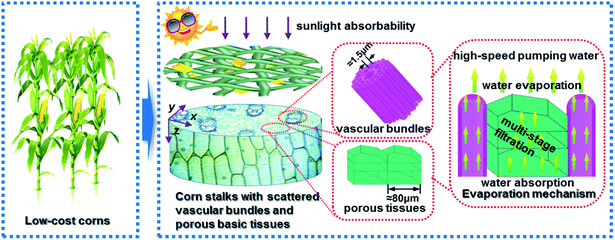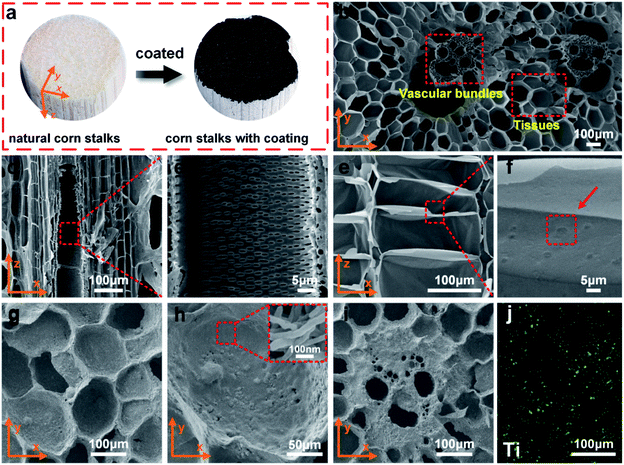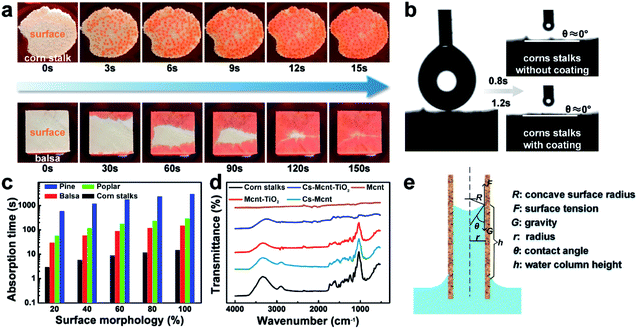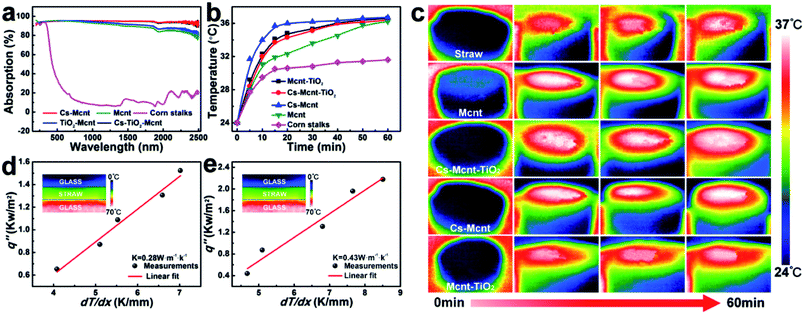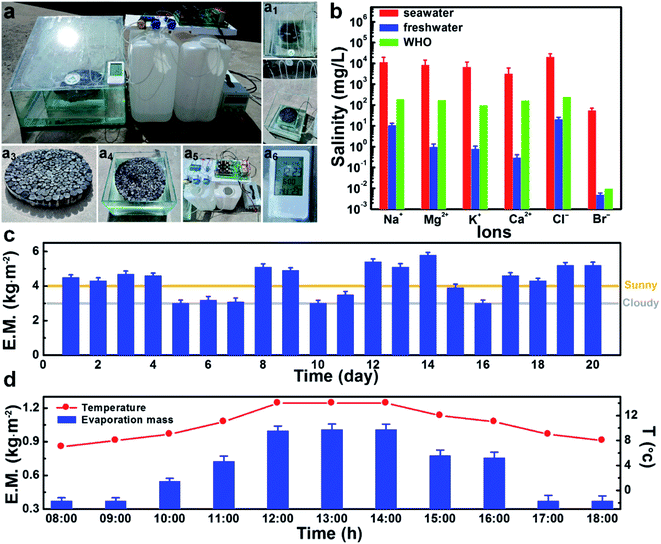A high-efficiency solar desalination evaporator composite of corn stalk, Mcnts and TiO2: ultra-fast capillary water moisture transportation and porous bio-tissue multi-layer filtration†
Zhuangzhi
Sun
 *ab,
Wenzong
Li
a,
Wenlong
Song
a,
Laichang
Zhang
*c and
Zuankai
Wang
*ab,
Wenzong
Li
a,
Wenlong
Song
a,
Laichang
Zhang
*c and
Zuankai
Wang
 *d
*d
aProvince Key Laboratory of Forestry Intelligent Equipment Engineering, College of Mechanical and Electrical Engineering, Northeast Forestry University, Harbin 150000, China. E-mail: sunzhuangzhi@nefu.edu.cn
bKey Laboratory of Bio-based Material Science & Technology, Ministry of Education, Northeast Forestry University, Harbin 150000, China
cSchool of Engineering, Edith Cowan University, 270 Joondalup Drive, Joondalup, WA 6027, Australia. E-mail: l.zhang@ecu.edu.au
dDepartment of Mechanical and Biomedical Engineering, City University of Hong Kong, Hong Kong, China. E-mail: zuanwang@cityu.edu.hk
First published on 27th November 2019
Abstract
Studies on solar steam evaporation for potential application in desalination have attracted much attention due to its unique advantages of low energy consumption environmental friendliness, etc. However, water molecule transportation in the capillaries of solar steam evaporators to develop a high-efficiency solar evaporation system is critical but often ignored. This work reports high-yield and low-cost natural corn stalks as solar steam generators with ultra-fast water transportation in capillaries, multi-layer self-cleaning of sea salt, large seawater storage capacity, long-term anti-corrosion properties against seawater, low thermal conductivity, and excellent evaporation properties. This solar steam evaporator with the conventional photothermal coating by multi-walled carbon nanotubes and titanium dioxide (Mcnt-TiO2) exhibits an outstanding evaporation rate of 2.48 kg m−2 h−1 and evaporation efficiency of 68.2% under solar light. These advantages are significantly attributed to the natural structural features of the stem marrow of corn stalks including scattered vascular bundles with super-hydrophilic properties achieving high-speed water moisture transportation, porous basic tissues with layer by layer bio-filtration, porous cavities realizing multi-stage filtration, transportation and storage of seawater, and low moisture enthalpy and heat loss. Meanwhile, an efficient and low-cost solar desalination device via bundling pluralities of corn stalks is developed to collect freshwater, and the average daily freshwater amount per unit area (4.3–5.8 kg m−2 on sunny days and 3.0–3.9 kg m−2 on cloudy days) can meet the daily water needs of more than twenty adults. These findings not only provide the possibility of discovering corn stalks as low-cost, scalable, highly efficient evaporation-based heat transfer devices for future efficient desalination, but also present an innovative inspiration for reducing the greenhouse effect brought by corn stalk burning, which promotes the efficient use of bio-mass straws.
At present, the lack of freshwater resources has become one of the global problems facing human society.1–6 In view of the severe challenges of water scarcity, solar-powered seawater desalination evaporation, as a clean and energy-saving way of regenerating freshwater resources, has become the most potential technology for the collection of freshwater resources in the future.7–9 Recent studies reported that solar steam evaporators via interfacial photothermal conversion principles achieve a wide range of broad-band sunlight absorbability to improve surface-to-surface photothermal conversion efficiency.10,11 Among them, absorbers such as carbon materials and metallic nanoparticles as solar steam evaporators are also important,12–15 and compared to previous carbon materials, hierarchically porous carbons from waste plastics are advantageous, and have been extensively studied.16 However, an efficient solar steam evaporation system needs to include four general features, namely broad-band sunlight absorbability, thermal management, water transportation, and water evaporation. Among these factors, it is generally believed that water moisture transportation in capillaries can meet the requirements of water evaporation, and the effects of moisture transfer characteristics on evaporation efficiency are often ignored. In fact, the water transportation of solar steam evaporators is subject to the capillary force that naturally raises the liquid for wetting the capillary wall, and the capillary force is strongly related to the internal pore size of the capillary and liquid surface tension.17 Therefore, without considering the interface photothermal conversion efficiency, the water transportation speed of solar steam evaporators significantly affects the water evaporation efficiency to a certain extent.
In nature, the transpiration channels of organisms are considered natural high-speed channels for water moisture transportation. Recently, solar steam evaporators based on wood root and rhizomes,18,19 mushroom prototypes,20 rice straw,21etc. have been reported taking advantage of their transpiration channels, natural hydrophilicity, low thermal conductivity, and shape features, which have great advantages in the manufacture of solar steam evaporators. Corn stalk is a kind of cheap and high-yielding gramineous plant, whose stem marrow is full and soft and occupies about 75% of the quality of the straw (removing the epidermis) and also constitutes transportation channels for internal water and nutrients. The stem marrow interface consists of loosely arranged porous basic tissues with large parenchyma cells and linear vascular bundles scattered with different pore sizes.22 However, studies surprisingly found that compared with rice straws21 and other gramineous plants,23 the stem marrow of corn stalks has richer porous basic tissues, which can collect impurities such as organic matter and ions in seawater. In addition to being used for upward transfer of water molecules, it can achieve self-cleaning separation of water molecules and impurities such as sea salt by multi-stage bio-filtration, and is an inexpensive, stable and readily replaceable bio-fiber sieve (see Fig. S9†). Furthermore, corn stalks contain twice as much seawater as woods at the same size, which is closely related to the porous cavities of the basic tissues similar to sponges (see Fig. 3(a) and S1†). More importantly, compared to other plants such as wood plants26,27 and mushrooms,20 the stem marrow of corn stalks has more scattered linear vascular bundles with a smaller average capillary aperture size, which greatly enhance the internal capillary force and improve the pumping water speed under the same liquid surface tension. The average time of water moisture transmission inside corn stalk at a height of 1 mm is about 2 s to achieve 100% coverage of the surface (Fig. S2 and Movie S2†). Additionally, studies showed that these corn stalks have good long-term anti-corrosion properties in seawater compared to the freshwater environment and a low moisture enthalpy with low heat loss. They can be immersed in seawater for more than 15 days without decay, which is very beneficial for long-term use in marine freshwater collection (see Fig. 5(d) and (e)). And the lower moisture enthalpy of corn stalks can achieve high-speed water evaporation, which is superior to that of wood roots under the same light intensity (see Fig. S7 and S8 and Table S1†).
Therefore, in this paper, a low-cost, universal solar steam evaporator made of the stem marrow of corn stalk is proposed as shown in Fig. 1. This solar steam evaporator has outstanding evaporation efficiency and multi-layer self-cleaning ability for sea salt, large seawater storage capacity, long-term anti-corrosion properties against seawater and low moisture enthalpy due to the natural structural features of the stem marrow of corn stalks including scattered vascular bundles with high-speed capillary water moisture transportation, and porous basic tissues with layer by layer bio-film filtration and seawater storage capacity. Furthermore, the designed efficient and low-cost solar desalination device presents excellent freshwater collection quality, and can daily produce 4.3–5.8 kg m−2 pure water on sunny days and 3.0–3.9 kg m−2 on cloudy days. The ultra-fast water moisture transportation properties realized by these natural characteristics have established a new way of inspiration for the study of the water evaporation efficiency of solar steam evaporators. Meanwhile, efficient use of corn stalks provides a new solution to reduce environmental pollution caused by straw incineration.
Fig. 2 shows the SEM images of the stem marrow of corn stalks and its internal microstructure. After cutting along the growth direction, the photothermal coating is applied to obtain solar steam evaporators (see Fig. 2(a)). Fig. 2(b) shows the SEM image of the microscopic surface of the pure stem marrow of corn stalks, significantly demonstrating the structure of the stem marrow including porous basic tissues and scattered linear vascular bundles. The scattered linear vascular bundles gradually decrease in the radial radius of the grid, and the size distribution in porous basic tissues is relatively uniform. A large number of microporous holes (about 0.5 μm–3 μm) are distributed in a single vascular bundle (see Fig. 2(c)), and these scattered vascular bundles collide with each other through this microporous structure to promote high-speed transportation of water molecules (see Fig. 2(d)). The basic tissue is formed by separating the individual channels through the bio-film (the cell wall is the main ingredient), where a large amount of microporous holes (about 0.5 μm–2 μm) is also distributed (see Fig. 2(e)), and these microporous holes can facilitate the realization of the multilayer filtration of corn stalks (see Fig. 2(f)). From Fig. 2(g)–(j), we can clearly see the surface morphology and the surface distribution of TiO2 (EDS) of the evaporator coated with light absorbers. The coated basic tissue film clearly shows the presence of MCNTs (see Fig. 2(h)), and the vascular bundle is partially covered by the coating (see Fig. 2(i)).
From the microscopic structure of the stem marrow of corn stalk it can be found that the linear vascular bundles penetrate the basic tissues and then lean into the internode forming multi-level branches, which are connected to each other and densely intertwined (see Fig. S1(a)†). The average diameter of the vascular bundles is about 1.5 μm. The basic tissues are loosely arranged with cell gaps, and the upper and lower thin-walled layers form multi-layered connection (see Fig. S1(a)†). The diameters of porous basic tissues are about 50–100 μm. By comparison, it was found that the seawater storage capacity of this sponge-like macroporous basic tissue was twice as large as that of woods at the same size (see ESI Fig. S1(b)†).
Fig. 3(a) shows that the water absorption time of corn stalks (about 10 s) along the vascular bundle direction to achieve 100% coverage of the surface is 15 times larger than that of balsa wood at the same size, which far exceeds the water molecule transfer rate of balsa wood (ESI Movie S1.†). The static contact angle (see Fig. 3(b)) confirms that the stem marrow of corn stalks is a natural super-hydrophilic material where the droplets were present for only 0.8 s on the surface. Furthermore, the corn stalks with the photothermal coating of Mcnt-TiO2 are also better super-hydrophilic materials. This super-hydrophilic property is the main reason for the ultra-fast water transfer rate of the vascular bundles. By comparing the water absorption characteristics along the vascular bundle direction (Fig. S2 and ESI Movies S2 and S6†), it can be seen that different stem marrows of corn stalks can achieve 20% water absorption area coverage within 3 s due to the natural super-hydrophilic structure.
Although different cross-section heights affect water transfer speed along the vascular bundles to a certain extent, the water transportation speed with a height of 1 mm is very impressive (within 1.5 s). The water absorption time of the porous basic tissue of biomass from the low end surface to the top surface indicated that the absorption time of the corn straw is very fast, and the water absorption speed is 10 times higher than that of other types of woods33 used in the fabrication of solar evaporation devices (balsa,23 pine, and poplar) (see Fig. 3(c) and Movies S1, S7 and S8†). This high-speed water moisture transfer in the vascular bundles is quite beneficial to the water evaporation from solar steam evaporators. Fig. 3(d) shows the FT-IR spectrum peaks of the coating surface and corn stalks. The doped coating of multi-walled carbon nanotubes (Mcnts) caused the disappearance of the spectrum peak of 1010 cm−1, which affects the surface hydrophilicity of corn stalks thereby causing different surface hydrophilicity between corn stalks and the photothermal coating. The surface super-hydrophilic properties of this corn stalk can be attributed to the smaller pore size of the dispersed vascular bundles (the average pore size is about 1.5 μm, as shown in Fig. 3(e)). After being placed in liquid seawater, water molecules quickly infiltrate the vascular bundle wall and the water molecules rise along the vascular bundle direction under the tension of the liquid surface. When the surface tension of liquid seawater which can be calculated by F = 2πrσ![[thin space (1/6-em)]](https://www.rsc.org/images/entities/char_2009.gif) cos
cos![[thin space (1/6-em)]](https://www.rsc.org/images/entities/char_2009.gif) θ is equal to the gravity generated in the vascular bundles which can be calculated by G = πr2hρg, the water column stops rising. Depending on the equation of h = 2σ
θ is equal to the gravity generated in the vascular bundles which can be calculated by G = πr2hρg, the water column stops rising. Depending on the equation of h = 2σ![[thin space (1/6-em)]](https://www.rsc.org/images/entities/char_2009.gif) cos
cos![[thin space (1/6-em)]](https://www.rsc.org/images/entities/char_2009.gif) θ/ρgr, the seawater rises under the capillary force by about 1 m under ideal conditions. In the above equations, r is the vascular bundle radius, θ is the contact angle between the liquid and the vascular bundle wall, σ is the liquid surface tension coefficient at room temperature of 25 °C (7.2 × 10−2 N m−1), h is the final height of seawater rising in the vascular bundles, ρ is the density of seawater, and g is the gravity constant.
θ/ρgr, the seawater rises under the capillary force by about 1 m under ideal conditions. In the above equations, r is the vascular bundle radius, θ is the contact angle between the liquid and the vascular bundle wall, σ is the liquid surface tension coefficient at room temperature of 25 °C (7.2 × 10−2 N m−1), h is the final height of seawater rising in the vascular bundles, ρ is the density of seawater, and g is the gravity constant.
Fig. 4 shows the thermal conductivity and thermal behavior of the solar steam evaporator made from the stem marrow of corn stalks, and the conventional substance of Mcnt-TiO2 was used as the photothermal coating in this work (ESI Fig. S6 and S10†). The stem marrow of corn stalks with different surface photothermal coatings irradiated by ultraviolet-visible spectrophotometer at a wavelength of 190–2500 nm, and the absorption and reflection ability of sunlight was measured (Fig. 4(a)). It can be seen that the lowest reflection efficiency of the conventional photothermal coating is about 4.5%, and the highest absorption efficiency is about 95.5%. Compared with the related reports on improving the photothermal conversion efficiency using photothermal coatings,4,20,21 the absorption and reflection effects of the visible light band of sunlight are relatively general. The corn stalks have a weaker absorption ability for light waves when the wavelength is lower than 400 nm. Therefore, it has changed dramatically at the visible light wavelength of 400 nm. IR images show that the temperature of the solar steam evaporators made of the stem marrow of corn stalks is increased rapidly. Due to the super-hydrophilic properties of the corn straw surface and the high-speed capillary moisture transfer characteristics, the surface layer of the solar steam evaporator remains wet and the surface temperature is maintained at around 37 °C. It takes about 5–10 min for the surface of the solar steam evaporator to rise to the maximum temperature (Fig. 4(b)). The temperature distribution of different photothermal coatings is shown in Fig. 4(c). The thermal conductivity of the stem marrow of corn stalk was tested by the thermal conductivity method of flux temperature difference fitting. The thermal conductivity of the stem marrow of corn stalks in the dry state is 0.28 W m−1 K−1, while it is 0.43 W m−1 K−1 in the wet state (Fig. 4(d) and (e)). It can be seen that the solar steam evaporators based on the stem marrow of corn stalk have relatively low thermal conductivity in the evaporation state and has good internal heat preservation characteristics, which are attributed to the porous basic tissues dividing the entire pore into different cavities and reducing the thermal conductivity. Thus, the low thermal conductivity of the stem marrow of corn stalk prevents the dissipation of the surface temperature and accumulates on the surface to raise the surface temperature.
A simulated solar evaporation experiment device was fabricated by a 3D printing method and operated under a solar simulator (see ESI Fig. S3†). Studies found that the evaporation ratio of rice straw under the photothermal coating of Mcnt-TiO2 is only 1.0 kg m−2 h−1, and the evaporation efficiency is 40%. However, the evaporation ratio of corn stalk under the photothermal coating of Mcnt-TiO2 can reach 2.48 kg m−2 h−1, and the evaporation efficiency is 68.2% (Fig. 5(a) and (b)). The evaporation efficiency (ref. 22, 24, 28 and 34) is defined as η = E.R.hlv/Coptqi, where E.R. is the evaporation rate, hlv denotes the total enthalpy of the liquid–vapor phase change, Copt stands for the optical concentration, and qi is the nominal solar irradiation (1 kW m−2). In addition to the lower evaporation ratio, when natural water enters the interior of the evaporation substrate, a part of the water combines with the hydrophilic tube energy group (–OH) contained in the evaporation substrate to form free water, and the remaining water is bound water. The formation of bound water in the interior of the evaporation substrate weakens the van der Waals force between the water molecules. Therefore, the free water in the evaporation substrate reduces the energy required for the process of forming water vapor, and the enthalpy value required for corn stalks therefore is lower than those required for tree plants (Fig. 5(c)). The enthalpy change of natural water is approximately equal to 2.4 kJ g−1, and the enthalpy values of different evaporation substrates are calculated by the formula of Eequ = EmEw (see ESI Fig. S7 and S8†), where Em is the ratio of the evaporation of the water content inside the evaporator in the dark per unit time to the evaporation of water, and Ew is the enthalpy of the water in the dark.
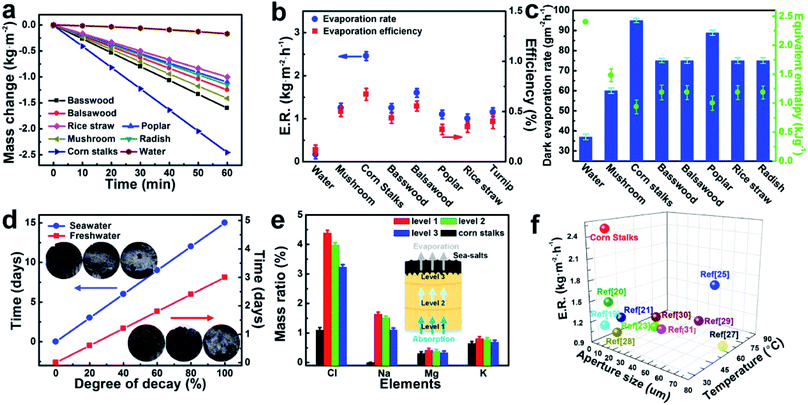 | ||
| Fig. 5 (a) Mass changes in water evaporation of different evaporation substrates under solar light, (b) evaporation ratio (blue, left) and evaporation efficiency (red, right) of different evaporation substrates under solar light, (c) evaporation ratio and enthalpy change values of different evaporation substrates in a dark environment, (d) long-term anti-corrosion resistance of the stem marrow of corn stalks in seawater (blue, left) and freshwater (red, right) (ref. 35), (e) EDS analysis of elemental content in different sections of the stem marrow of corn stalk based solar steam evaporators, and (f) comparison of evaporation ratio parameters of solar steam evaporators under different types of porous media (ref. 19, 20, 23, 25, 26, 27 and 30 – wood roots and rhizomes, ref. 20 – mushrooms, ref. 21 – rice straws, and ref. 29 – daikon). | ||
In order to ensure that the corn stalks have a long working life in seawater, experiments were carried out in underground freshwater and seawater. Studies showed that compared with freshwater, the anti-corrosion properties of corn stalks in seawater are maintained for 15 days, which is 5 times better than that in a freshwater environment. This is due to the fact that seawater has a certain bactericidal effect (Fig. 5(d)). In order to confirm the significant filtration effect of the porous basic tissues on sea salt, the EDS element scanning analysis was performed on the segmentation positions of different vascular bundle directions (Fig. 5(e) and ESI Fig. S4†). It can be seen that Na and Cl elements are detected at different segmentation positions, which indicates that water molecules passed through the vascular bundles and the porous basic tissues, and the contents of the Na and Cl elements decrease with the gradient of the segmentation position toward the direction of water evaporation. This indicates that the porous basic tissues have a multi-layer bio-filtration effect on sea salt to some extent.
The excellent hydrophilicity of the stem marrow of corn stalks has a significant effect on the evaporation efficiency of the solar steam evaporator, which is closely related to the capillary force of the natural structure. The channel size of the capillary is the main limiting factor under the surface tension of the same liquid. At the same time, due to the large thermal conductivity of liquid water, the surface temperature of the solar steam evaporator is strongly affected by the water moisture amount. The materials with low surface temperature indicate that the porous mediums, such as corn stalks and tree plants, have excellent hydrophilicity. Through the comprehensive comparison of the surface temperature and the capillary diameters of the previously reported biomass solar steam evaporators (Fig. 5(f)), it is found that the water evaporation ratio of the stem marrow of the corn stalk based evaporator is far ahead, which depends on the fact that the stem marrow of corn stalk has a smaller vascular bundle diameter and enables ultra-fast water transportation in the capillaries.
A simple preparation method and green consumables are utilized to manufacture an efficient and low-cost solar desalination device in this work (Fig. 6(a), ESI Fig. S5 and Movie S9†). The overall sizes of the whole device are 500 mm long, 500 mm wide and 400 mm high, and the overall manufacturing cost of disk-shaped corn stalks with the photothermal coating is about ¥10 RMB m−2. The plurality of corn stalks was bundled into a disk shape, and cut according to the growth direction (having a height of 30 mm). Furthermore, the TiO2-Mcnt photothermal layer was manually coated, and then air-dried at room temperature, which can be stably attached to the straw surface. Finally, solar steam evaporation was carried out in a glass greenhouse. By measuring the concentration of major cations in seawater before and after evaporation (Fig. 6(b)), the typical sensory index of Na+ (10 mg L−1), the toxicological index of Sr2+ (0.04 mg L−1) and the concentration of Cl− (21 mg L−1) and Br− (0.005 mg L−1) can meet the drinking water standard of World Health Organization (WHO).31 This confirms that the disposable solar evaporation proposed in this paper can meet the standard of seawater desalination compared to the multi-stage distillation method. Meanwhile, the characteristics of solar seawater evaporation under room temperature and humidity conditions (the average temperature 10 °C and the average humidity 23%) in a specific region (Harbin, China in April) were tested by experiments (Fig. 6(c)). Studies found that the water evaporation mass is 4.3–5.8 kg m−2 per day on sunny days and the water evaporation mass is 3.0–3.9 kg m−2 per day on cloudy days. During the daytime, the highest outdoor temperature period has the highest per unit area evaporation mass, and the average daily freshwater collection per unit area can meet the daily freshwater drinking needs of more than 20 adults (about 0.2 kg fresh water per day for normal adults32) (Fig. 6(d)).
In summary, this work reports a solar steam generator via natural super-hydrophilic corn stalks with the photothermal coating of Mcnt-TiO2, achieving highly efficient freshwater extraction in desalination. These natural structural advantages including scattered vascular bundles and porous basic tissues can achieve ultra-fast water transportation in capillaries (15 times higher than woods), disposable multi-layer self-cleaning desalination of sea salt (see ESI Fig. S9†), large seawater storage capacity (2 times higher than woods per unit volume), long-term anti-corrosion properties against seawater (about 15 days) and, low thermal conductivity (0.28 W m−1 K−1 at dry state) and excellent evaporation characteristics (evaporation rate of 2.48 kg m−2 h−1 and evaporation efficiency of 68.2%). The excellent evaporation characteristics of solar steam evaporators are mainly attributed to the super-hydrophilic properties and low water enthalpy change (0.93 kJ g−1) of the stem marrow of corn stalks, which are mainly derived from scattered vascular bundles with large capillary force for molecule transportation and porous basic tissues with a multi-stage molecular filtration sieve for water and organic impurity separation. To further explore the possibility of natural corn stalk application, a solar desalination device is designed to achieve the extraction of freshwater resources by bundling to construct superimposed corn stalks, which daily produce 4.3–5.8 kg m−2 pure water on sunny days and 3.0–3.9 kg m−2 on cloudy days. It is definitely believed that the efficient use of corn stalks will have great potential in the future. In addition to solving the environmental problems caused by direct combustion, this kind of low-cost, high-yield corn stalk plays a more important role in fields such as bio-fertilizer, nano-energy, bio-manufacturing, and so on.
The surface super-hydrophilic properties of corn stalk are mainly derived from the smaller capillary aperture size of the scattered vascular bundles, which produces a large capillary force. This capillary force can break the binding of gravity and accelerate the upward movement of water molecules within capillaries. Thus, the solar steam evaporator enables ultra-fast water transportation in the capillaries. Furthermore, this super-hydrophilic property of corn stalks allows the solar steam evaporators to have a lower thermal conductivity, which accelerates the increase in surface temperature, but also because of this super-hydrophilic property, the water molecules in capillaries attain high speed to reduce the surface temperature.
Meanwhile, this disposable filtration to reach the desalinated water standard is primarily derived from the porous basic structure similar to a sponge. These basic tissues have porous cavities and a nano-sized bio-film to form a molecular filter sieve. In this way, the organic impurities and freshwater can be effectively separated by bio-film layers, especially for macromolecule substances such as sea salt, which can be effectively blocked inside the basic tissue of corn stalks. Also, this sponge-like porous basic tissue achieves water molecule transportation and contains more seawater than woods at the same size. Because the porous basic tissue has a larger pore size (50–100 μm) and a thinner cell wall, it is more conducive to the storage and transportation of water molecules inside the corn stalks.
Experimental section
Materials preparation
Corn stalks were purchased from Heilongjiang Province, China. Fresh corn stalks were dried under natural conditions and the stem marrow of corn stalks was picked out, which was cut into different cylindrical pieces length along the growth direction. TiO2 (20 nm, hydrophilic), multi-walled carbon nanotube (Mcnts, Carbon tube content 10.6%, carbon nanotube length 10–20 μm, diameter ≥ 50 nm) powder and chitosan (Cs) powder were purchased from Yongchang Co. Ltd. in Harbin, China.Coating membrane preparation
The composite photothermal coatings are prepared as follows. The mixed solution for preparing the photothermal coatings was applied to the corn stalk surface and naturally dried at room temperature. (1) Mcnt coating: Mcnt aqueous dispersion (homemade). (2) Mcnt-TiO2 coating: 0.125 g of TiO2 was dissolved in 1 mL of Mcnt aqueous dispersion. (3) Cs-Mcnt coating: 0.2 g of Cs was stirred and dissolved in 20 mL of acetic acid (HAc) under water bath conditions of 60 °C. 1 mL of Mcnt aqueous dispersion is added and dispersed evenly. (4) Cs-Mcnt-TiO2 coating: 0.2 g of Cs was dissolved in 20 mL HAc by stirring under water bath conditions of 60 °C. Then, 0.4 g of TiO2 was added, and 1 mL of the Mcnt aqueous dispersion was added, which was evenly dispersed.Material characterization
The microstructure of corn stalk was characterized by scanning electron microscopy (JSN-7500F cold field emission scanning electron microscope with an accelerating voltage of 5 kV). The Fourier Transform Infrared Spectrometer (FT-IR) spectrum with a test spectral range of 4000–500 cm−1 was obtained using a Nicolet iS50. The optical transmittance and reflectance spectra of the photothermal coatings were measured using an ultraviolet-visible spectrophotometer in the range of 190–2500 nm. The absorption efficiency was calculated by A = 1 − R − T, where R and T are the reflection and transmission efficiency. Infrared photos were taken using an HT-18 infrared camera. The super-hydrophilic properties of the surface were measured using a visual optical contact angle meter (OCA20). The ion concentration before and after desalination was tested using an inductively coupled plasma spectrometer (ICP-OES) and ion chromatograph instrument (ICS-600).Thermal conductivity measurement
A dry stem marrow or wet corn stalk (thickness of 5 mm) was placed between two glass sheets, whose upper glass is provided with a groove for placing the ice water mixture and the lower glass is placed under a controlled heat source containing water. An infrared thermal imager was used to observe the temperature gradient of the intermediate samples. The thermal conductivity of each sample was calculated using q′′ = KdT/dx, where q′′ is the heat flux, which can be evaluated by the thermal conductivity and the temperature gradient of the glass slide, dT refers to temperature difference, and dx is the distance difference.Evaporation efficiency measurement
When the temperature of the coated stem marrow surface was stable, solar steam evaporation at room temperature was achieved. The evaporation rate was calculated using the formula of E.R. = 10![[thin space (1/6-em)]](https://www.rsc.org/images/entities/char_2009.gif) 000m/st, where m is the mass reduction unit (kg), s is the upper surface area unit (cm2), and t is the evaporation time (h).
000m/st, where m is the mass reduction unit (kg), s is the upper surface area unit (cm2), and t is the evaporation time (h).
Experimental devices
The top open plastic polyethylene sheet was placed in a container filled with freshwater, and then the corn stalk based solar steam generator was placed in a plastic structure at room temperature of 9 °C and a humidity of 25%. The coated portion of the solar steam generator was exposed to natural sunlight, and the experimental device was placed on the electronic balance using a solar simulator (CEL-SA500/350 xenon lamp). When the solar simulator was switched on, the transient mass of the produced freshwater was recorded (Fig. S3†).Funding
The authors gratefully acknowledge the financial support by the China Postdoctoral Science Foundation Funded Project (Grant No. 2018M630330 & No. 2019T120245), Natural Science Foundation of Heilongjiang Province (Grant No. QC2018046), National Natural Science Foundation of China (Grant No. 51905085), and Fundamental Research Funds for the Central Universities (Grant No. 2572017PZ12).Author contributions
Z. S. proposed and supervised the project, and wrote the paper, W. L. designed and performed the experiments as well as processing the experimental data. W. S. provided funding to support this work. L. Z. and Z. W. checked out the article and language writing, and provided valuable advices on the processing of experimental data. All authors have given approval to the final version of the manuscript.Data and materials availability
All data needed to evaluate the conclusions in this work have been provided in the paper and/or the ESI.† Additional data related to this work may be requested from the authors.Conflicts of interest
All authors have given approval to the final vision of the interests.Notes and references
- C. J. Vörösmarty, P. B. McIntyre, M. O. Gessner, D. Dudgeon, A. Prusevich, P. Green, S. Glidden, S. E. Bunn, C. A. Sullivan, C. Reidy Liermann and P. M. Davies, Nature, 2010, 467(7315), 555 CrossRef.
- J. G. Hering and K. M. Ingold, Science, 2012, 336(6086), 1234–1235 CrossRef CAS.
- T. Li, Q. Fang, X. Xi and F. Liu, J. Mater. Chem. A, 2019, 7(2), 586–593 RSC.
- G. Ni, G. Li and S. V. Boriskina, Nat. Energy, 2016, 1(9), 16126 CrossRef CAS.
- F. Zhao, X. Zhou and Y. Shi, Nat. Nanotechnol., 2018, 13(6), 489 CrossRef CAS.
- P. Tao, G. Ni and C. Song, Nat. Energy, 2018, 3, 1031–1041 CrossRef.
- X. Yang, Y. Yang, L. Fu, M. Zou, Z. Li, A. Cao and Q. Yuan, Adv. Funct. Mater., 2018, 28(3), 1704505 CrossRef.
- L. Zhu, L. Sun, H. Zhang, D. Yu, H. Aslan, J. Zhao, Z. Li, M. Yu, F. Besenbacher and Y. Sun, Nano Energy, 2019, 57, 842–850 CrossRef CAS.
- Q. Jiang, L. Tian, K. K. Liu, S. Tadepalli, R. Raliya, P. Biswas and R. Rajesh, Adv. Mater., 2016, 28(42), 9400–9407 CrossRef CAS.
- Y. Li, T. Gao, Z. Yang, C. Chen, W. Luo, J. Song, E. Hitz, C. Jia, Y. Zhou, B. Liu, B. Yang and L. Hu, Adv. Mater., 2017, 29(26), 1700981 CrossRef.
- L. Zhu, M. Gao, C. K. N. Peh, X. Wang and G. W. Ho, Adv. Energy Mater., 2018, 8(16), 1702149 CrossRef.
- Q. Wang, L. Qiu and Y. Jia, Sol. Energy Mater. Sol. Cells, 2019, 202, 110116 CrossRef CAS.
- J. Gong, X. Chen and T. Tang, Prog. Polym. Sci., 2019, 94, 1–32 CrossRef CAS.
- J. Yin, Q. Zhao and J. Wu, ACS Nano, 2018, 12(12), 12551–12557 CrossRef.
- J. Gong, H. Lin and M. Antonietti, J. Mater. Chem. A, 2016, 4(19), 7313–7321 RSC.
- B. Zhang, C. Song and C. Liu, J. Mater. Chem. A, 2019, 7, 22912–22923 RSC.
- H. Zhang, Y. Liu, C. Yang, L. Xiang, Y. Hu and L. M. Peng, Adv. Mater., 2018, 30(50), 1805408 CrossRef PubMed.
- C. Jia, Y. Li, Z. Yang, G. Chen, Y. Yao, F. Jiang, Y. Kuang, G. Pastel, H. Xie, B. Yang, S. Das and L. Hu, Joule, 2017, 1(3), 588–599 CrossRef.
- H. Liu, C. Chen and G. Chen, Adv. Energy Mater., 2018, 8(8), 1701616 CrossRef.
- N. Xu, X. Hu, W. Xu, Y. Kuang, X. Zhao, J. Song, C. Jia, X. Xu, E. Hitz, H. Xie, S. Wang, F. Jiang, T. Li, Y. Li, A. Gong, R. Yang, S. Das and L. Hu, Adv. Mater., 2017, 29(28), 1606762 CrossRef.
- Q. Fang, T. Li, Z. Chen, H. Lin, P. Wang and F. Liu, ACS Appl. Mater. Interfaces, 2019, 11(11), 10672–10679 CrossRef CAS PubMed.
- Y. Guo, X. Zhou and F. Zhao, ACS Nano, 2019, 13(7), 7913–7919 CrossRef CAS PubMed.
- C. Chen, Y. Li, J. Song, Z. Yang, Y. Kuang, E. Hitz, C. Jia, A. Gong, F. Jiang, J. Y. Zhu, B. Yang, J. Xie and L. Hu, Adv. Mater., 2017, 29(30), 1701756 CrossRef.
- T. Li, H. Liu and X. Zhao, Adv. Funct. Mater., 2018, 28(16), 1707134 CrossRef.
- F. Liu, B. Zhao, W. Wu, H. Yang, Y. Ning, Y. Lai and R. Bradley, Low Cost, Robust, Adv. Funct. Mater., 2018, 28(47), 1803266 CrossRef.
- M. Zhu, Y. Li, F. Chen, M. Zhu, Y. Li, F. Chen, X. Zhu, J. Dai, Y. Li, Z. Yang, X. Yan, J. Song, Y. Wang, E. Hitz, W. Luo, M. Lu, B. Yang and L. Hu, Adv. Energy Mater., 2018, 8(4), 1701028 CrossRef.
- G. Xue, K. Liu, Q. Chen, P. Yang, J. Li, T. Ding, J. Duan, B. Qi and J. Zhou, ACS Appl. Mater. Interfaces, 2017, 9(17), 15052–15057 CrossRef CAS.
- Y. Wang, H. Liu, C. Chen, J. Song, H. Xie, C. Jia, S. Kronthal, X. Xu, S. He and L. Hu, Adv. Sustainable Syst., 2019, 3(1), 1800055 CrossRef.
- M. Zhu, J. Yu, C. Ma, C. Zhang, D. Wu and H. Zhu, Sol. Energy Mater. Sol. Cells, 2019, 191, 83–90 CrossRef CAS.
- X. Luo, C. Huang, S. Liu and J. Zhong, Int. J. Energy Res., 2018, 42(15), 4830–4839 CrossRef.
- World Health Organization, World Health Organization Guidelines for Drinking Water Quality, World Health Organization, Geneva, Switzerland, 2004 Search PubMed.
- B. W. Ibelings and I. Chorus, Environ. Pollut., 2007, 150(1), 177–192 CrossRef CAS.
- C. Jia, Y. Li and Z. Yang, Joule, 2017, 1(3), 588–599 CrossRef.
- C. Chen, Y. Kuang and L. Hu, Joule, 2019, 3(3), 683–718 CrossRef CAS.
- Y. Kuang, C. Chen and S. He, Adv. Mater., 2019, 1900498 CrossRef PubMed.
Footnote |
| † Electronic supplementary information (ESI) available. See DOI: 10.1039/c9ta10898j |
| This journal is © The Royal Society of Chemistry 2020 |

